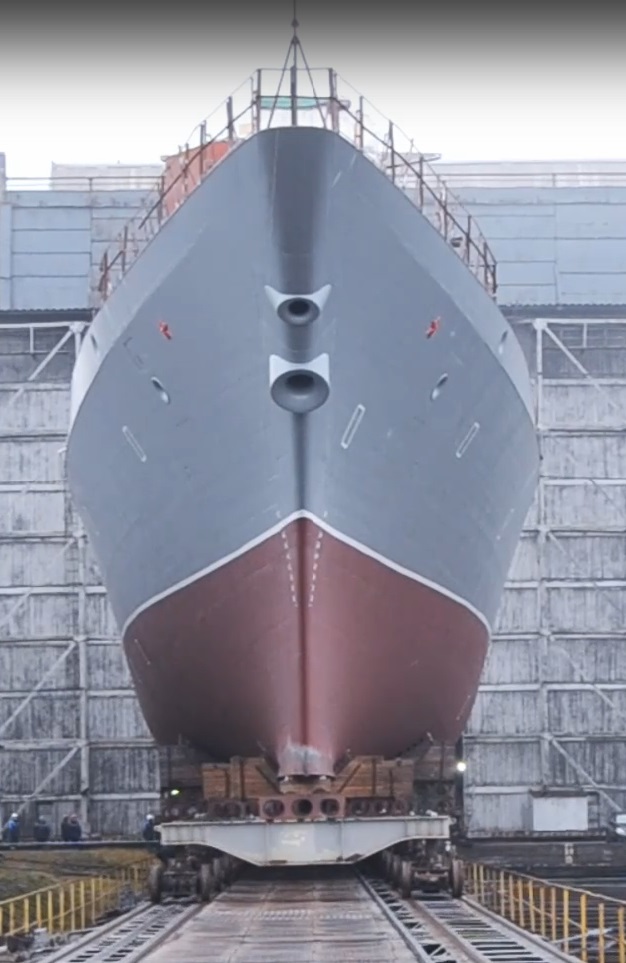On December 25th, 2019, the project 20380 Steregushchiy-class corvette – Retiviy, was launched at the Severnaya Verf Shipyard.
The laying ceremony for the Russian Navy of two project 20380 corvettes – Retiviy and Strogiy was held at PJSC Severnaya Verf Shipyard on February 20th, 2015.
So far, the Severnaya Verf Shipyard has produced four project 20380 corvettes, including the leading warship Steregushchiy. The first ship was launched on February 28th, 2008. While the other three – Soobrazitelniy, Boyky and Stoikiy were respectively commissioned in 2010, 2011 and 2012.
All four of the ships were commissioned and have undertaken combat duty.
Two other project 20380 corvettes were produced at the Amur Shipyard in Komsomolsk-on-Amur – Sovershennyy and Gromkiy.
Apart from the Retiviy, one more warship the Strogiy is being currently built at the Severnaya Verf Shipyard.
Two more corvettes of the class are being built at the Amur Shipyard, bringing the total number to 10 Project 20380 corvettes.
Further construction of corvettes for the Russian Navy at the Severnaya Verf was supposed to be carried out according to the revised project 20385.
The lead ship of the project 20385 Gremyashchy was laid down at the enterprise on February 1st, 2012. It was launched on June 30th 2017, and it began factory sea trials on April 21st, 2019, and the second – Provorniy was laid down on July 25th, 2013 and launched in September 2019.
However, due to the fact that the project 20385 corvettes were supposed to be equipped with MTU German diesel engines, the supply of which became impossible due to Western sanctions imposed against Russia in 2014, the further construction of the project series 20385 was discontinued, and the Russian Navy returned to the construction of project 20380 corvettes under an readjusted project program.
The Project 20380 Steregushchiy-class corvettes have a steel hull and composite material superstructure, with a bulbous bow and nine watertight subdivisions. They have a combined bridge and command centre, and space and weight provision for eight SS-N-25 missiles. Stealth technology was widely used during construction of the ships, as well as 21 patents and 14 new computer programs. Newest physical field reduction solutions were applied too. As a result, designers considerably reduced the ship’s radar signature thanks to hull architecture and fire-resistant radar-absorbent fiberglass applied in tophamper’s design.
Its technical characteristics are the following:
- Displacement: 1,800 tons, and 2,200 tons at full load;
- Length: 5 m;
- Beam:6 m;
- Draught:7 m;
- Power: 380/220 V AC, 50 Hz, 4×630 kW diesel genset;
- Propulsion: 2 shaft CODAD, 4 Kolomna 16D49 diesels 23,664 hp (17.6 MW);
- Speed: 27 knots;
- Range: 3,800 nautical miles;
- Endurance: 15 days;
- Complement: 90;
Sensors and processing systems:
- Air search radar: Furke 2 (Furke-E, Positiv-ME1, SMILE Thales for export);
- Surface search radar: Granit Central Scientific Institute Garpun-B/3Ts-25E/PLANK SHAVE radar, Monument targeting radar;
- Fire control radar: Ratep 5P-10E Puma for A-190;
- Sonar: Zarya-M (Zarya-ME for export) suite, bow mounted. Vinyetka low frequency active/passive towed array;
- Navigation: Gorizont-25 integrated navigation system;
- Electronic Warfare Suite: TK-25E-5 ECM;
- Countermeasures: 4 x PK-10 decoy launchers;
Armament:
- 1 × 100mm A-190 Arsenal or 130mm A-192 naval gun
- 1 × Kashtan CIWS-M
- 2 × 4 Kh-35 (SS-N-25)
- 2 × AK-630М CIWS
- 2 × 4 330mm torpedo tubes for Paket-NK (Paket-NK/E for export) anti-torpedo/anti-submarine torpedoes
- 2 × 14.5mm MTPU pedestal machine guns
It has a hangar for a Ka-27 Helicopter, as well as a launchpad for Orlan-10 UAV.
MORE ON THE TOPIC:








Good to see Russia creating a fast hard hitting modern navy. In the age of hypersonic missiles carriers are a death trap and a waste, just for symbolic show.
Hopefully Russia will speed up building frigates Project 22350 Groshkov class and soon start project 22350M destroyers that are badly needed to replace old Soviet ships of that size.